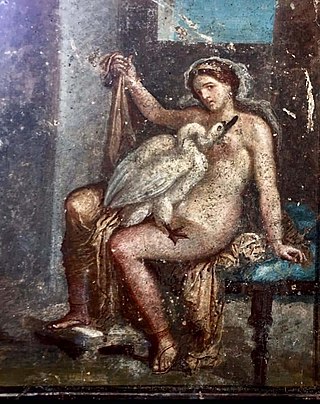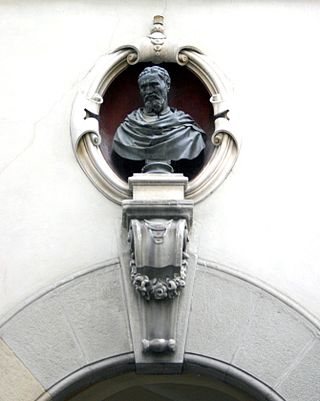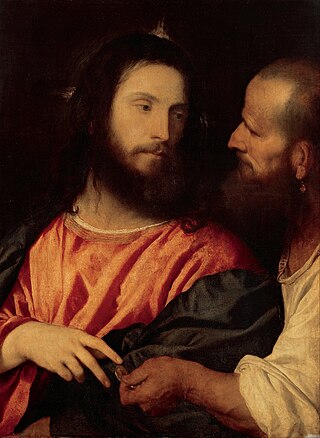
Leda and the Swan is a story and subject in art from Greek mythology in which the god Zeus, in the form of a swan, seduces or rapes Leda. According to later Greek mythology, Leda bore Helen and Polydeuces, children of Zeus, while at the same time bearing Castor and Clytemnestra, children of her husband Tyndareus, the King of Sparta. According to many versions of the story, Zeus took the form of a swan and raped Leda on the same night she slept with her husband King Tyndareus. In some versions, she laid two eggs from which the children hatched. In other versions, Helen is a daughter of Nemesis, the goddess who personified the disaster that awaited those suffering from the pride of Hubris.

Michelangelo di Lodovico Buonarroti Simoni, known as Michelangelo, was an Italian sculptor, painter, architect, and poet of the High Renaissance. Born in the Republic of Florence, his work was inspired by models from classical antiquity and had a lasting influence on Western art. Michelangelo's creative abilities and mastery in a range of artistic arenas define him as an archetypal Renaissance man, along with his rival and elder contemporary, Leonardo da Vinci. Given the sheer volume of surviving correspondence, sketches, and reminiscences, Michelangelo is one of the best-documented artists of the 16th century. He was lauded by contemporary biographers as the most accomplished artist of his era.

Antonio Allegri da Correggio, usually known as just Correggio, was the foremost painter of the Parma school of the High Italian Renaissance, who was responsible for some of the most vigorous and sensuous works of the sixteenth century. In his use of dynamic composition, illusionistic perspective and dramatic foreshortening, Correggio prefigured the Baroque art of the seventeenth century and the Rococo art of the eighteenth century. He is considered a master of chiaroscuro.

In Greek mythology, Leda was an Aetolian princess who became a Spartan queen. According to Ovid, she was famed for her beautiful black hair and snowy skin. Her myth gave rise to the popular motif in Renaissance and later art of Leda and the Swan.

Sebastiano del Piombo was an Italian painter of the High Renaissance and early Mannerist periods famous as the only major artist of the period to combine the colouring of the Venetian school in which he was trained with the monumental forms of the Roman school. He belongs both to the painting school of his native city, Venice, where he made significant contributions before he left for Rome in 1511, and that of Rome, where he stayed for the rest of his life, and whose style he thoroughly adopted.

Benvenuto Tisi was a Late-Renaissance-Mannerist Italian painter of the School of Ferrara. Garofalo's career began attached to the court of the Duke d'Este. His early works have been described as "idyllic", but they often conform to the elaborate conceits favored by the artistically refined Ferrarese court. His nickname, Garofalo, may derive from his habit of signing some works with a picture of a carnation.

Alfonso d'Este was Duke of Ferrara during the time of the War of the League of Cambrai.

Niccolò di Raffaello di Niccolò dei Pericoli, called "Il Tribolo" was an Italian Mannerist artist in the service of Cosimo I de' Medici in his natal city of Florence.

Giuliano di Piero di Simone Bugiardini was an Italian Renaissance painter. He was born and was mainly active in Florence. He was a painter primarily of religious subjects but he also executed a number of portraits and a few works with mythological subjects.

The story of Leda and the Swan was the subject of two compositions by Leonardo da Vinci from perhaps 1503–1510. Neither survive as paintings by Leonardo, but there are a number of drawings for both by him, and copies in oils, especially of the second composition, where Leda stands.

Casa Buonarroti is a museum in Florence, Italy. The building was a property owned by the sculptor Michelangelo, which he left to his nephew, Leonardo Buonarroti. The house was converted into a museum dedicated to the artist by his great nephew, Michelangelo Buonarroti the Younger. Its collections include two of Michelangelo's earliest sculptures, the Madonna of the Stairs and the Battle of the Centaurs. A ten-thousand book library includes the family's archive and some of Michelangelo's letters and drawings. The Galleria is decorated with paintings commissioned by Buonarroti the Younger and created by Artemisia Gentileschi and other early seventeenth-century Italian artists.

The Battle of Cascina is a never-completed painting in fresco commissioned from Michelangelo for the Palazzo Vecchio in Florence. He created only the preparatory drawing before being called to Rome by Pope Julius II, where he worked on the Pope's tomb; before completing this project, he returned to Florence for some months to complete the cartoon.

Tommaso dei Cavalieri was an Italian nobleman, who was the object of the greatest expression of Michelangelo's love. Michelangelo was 57 years old when he met Cavalieri in 1532. The young noble was exceptionally handsome, and his appearance seems to have fit the artist's notions of ideal masculine beauty, for Michelangelo described him as "light of our century, paragon of all the world". The two men remained close to each other throughout their lives and Cavalieri was present at the artist's death.

The Tribute Money is a panel painting in oils of 1516 by the Italian late Renaissance artist Titian, now in the Gemäldegalerie Alte Meister in Dresden, Germany. It depicts Christ and a Pharisee at the moment in the Gospels when Christ is shown a coin and says "Render unto Caesar the things that are Caesar's, and unto God the things that are God's". It is signed "Ticianus F.[ecit]", painted on the trim of the left side of the Pharisee's collar.
The Bearded Slave is a marble sculpture by Michelangelo datable to around 1525–1530 and kept in the Galleria dell'Accademia in Florence. It forms part of the series of unfinished Prigioni intended for the Tomb of Pope Julius II.

The Awakening Slave is a 2.67m high marble statue by Michelangelo, dated to 1525-1530. It is one of the 'Prisoners', the series of unfinished sculptures for the tomb of Pope Julius II. It is now held in the Galleria dell'Accademia in Florence.

Leda and the Swan is an oil painting by Peter Paul Rubens, who painted two versions of this subject. The first was completed in 1601 and the second in 1602.
Charles de Tolnay, born Károly von Tolnai, was a Hungarian art historian and an expert on Michelangelo. According to Erwin Panofsky, he was "one of the most brilliant art historians" of his time.

Leda and the Swan is an oil on canvas painting from 1530–31 by the Italian painter Correggio, now in the Gemäldegalerie in Berlin. It shows three scenes of Leda's seduction by Jupiter who has taken the form of a swan. Their first meeting is shown on the right hand side and their lovemaking in the centre, where Leda sits with the swan between her thighs, guiding him with her left hand. They are accompanied to their left by Cupid with his bow and two cupids with flutes. The third scene is the swan flying away whilst Leda gets dressed. Leda and the Swan was a common subject in 16th-century art.

Kneeling Leda with Her Children is a 16th-century painting by Leonardo da Vinci's pupil Giampietrino. It is now in the Gemäldegalerie Alte Meister (Kassel).



















